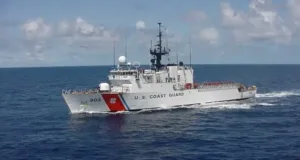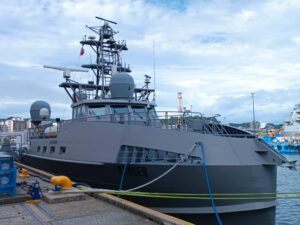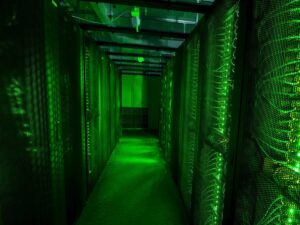Civilian Mariners Support US Navy
A civil service mariner (CIVMAR) is a US federal government employee who pursues a civil service career while assigned aboard U.S. government-owned ships supporting the US Navy’s warfighters and warfighting platforms deployed world wide.Such CIVMARs comprise almost 80% of US Navy workforce and reflect standards found aboard civilian merchant or commercial vessels instead of fighting ships.
The CIVMAR comprise of licensed personnel including ship’s master and chief engineer in possession of U.S. Coast Guard-issued license obtained through a combination of sea time and successful completion of a licensing exam.
 Credit : NAVALNEWS
Credit : NAVALNEWS
Mariners in Royal Navy
Vessels are commanded by civilian masters rather then Naval commissioned officers. The phrase “in the charge of” is at times constructively interpreted to include a remote shore based team for unmanned vessels.The Royal Forces Auxiliary (RFA) is essentially a merchant navy organisation of civilian-crewed ships providing vital logistic and operational support to the Royal Navy and Royal Marines nowadays being the biggest British employer of British non-military merchant navy sailors.These civilian mariners don Royal Navy uniforms complimented with Merchant Navy styled insignia and benefits include civil service pensions and maritime industry recognised qualifications. The Royal Navy and industry bodies provide internationally recognized training to raw recruits who may have no prior maritime credentials.
Crewing Shortages
The Royal Navy’s Fleet Auxiliary and also the U.S. Navy’s Military Sealift Command are going for stacking tonnage on account of recruitment issues .The Military Sealift Command (MSC) is the civilian-crewed auxiliary force for the U.S. Navy .As a way to cut costs for the regular Navy the MSC vessels such as dry stores ships and fleet oilers provide ammunition and fuel to sustain surface combatants complemented by a diverse complement of special-purpose auxiliaries including submarine trackers, surveillance ships, salvage tugs and other specialized vessels . The USNI reveals that MSC’s roster has about 1.3 mariners for every seagoing billet which is unable to manage consistent rotations for the 4,500 crewmembers on board at any given time. A radical program being proposed is sidelining all of MSC twelve actively serving expeditionary fast transports , along with two civilian-crewed sea base ships, two Lewis & Clark-class dry cargo replenishment ships and one fleet oiler.The outcome would be to eliminate around 700 seagoing billets in order to shore up mariner-to-billet ratio from 1.3 to 1.5 enabling a better quality of life for seagoing personnel.
This elimination of billets would be despite the advanced expeditionary fast transports high-speed intratheater fast ferries with built in aluminum for light weight and fitted with a ramp for vehicle loading with a huge capacity of 600 tonnes, top speed of up to 45 knots, a 26-member civilian crew and the diplomatic impact of goodwill port calls and relief missions.
Royal Fleet Auxiliary stacks multiple vessels
The Royal Fleet Auxiliary’s salary structure has not hedged against inflationary whereas commercial mariners are paid in accordance with rise in inflation in the UK. Although unprecedented the Royal Auxiliary’s union has gone on strike on more then one occasion with the RFA unable to deploy several vessels as it lacks the personnel for full crew complement. For example RFA Tiderace, a fleet oiler that entered service just six years ago, is cold-stacked on account of a crewing shortage. A state of the art mine countermeasures vessel RFA Stirling Castle has been similarly sidelined
Chinese People’s Liberation Army & Auxiliary Ships
The Chinese People’s Liberation Army (PLA) Navy operates a large fleet of auxiliary ships that provide logistics and combat support in all areas including the frontiers of the South China Sea the current maritime conflict zone. The PLA Navy auxiliary vessels include comprehensive replenishment ships with displacements of dozens of thousand tons as well as landing ships, degaussing ships ,remote-controlled target ships, hospital ships, oil tankers and water tankers boasting displacements of several thousand tons. Interestingly the PLA Navy water tanker role to replenish fresh water to islands and vessels which the Royal Navy and the US Navy lacks thefore China has a distinct advantage if it colonizes islands in the South China Sea. Intriguingly the Nanqin 205 degaussing ship plays a key role in creating a stealth cover. Magnetic fields are inevitably generated by the Earth’s magnetic field around vessels as they sail exposing to hostile navies and the degaussing ship’s cleanse other vessels of their magnetic fields.
 Credit;The Maritime Executive
Credit;The Maritime Executive
In the South China Sea the US – Philippine maritime axis is oriented towards increased domain awareness by adopting Military Grade Artificial Intelligence (AI) advanced cyber intelligence . The U.S has supplied the Philippine Navy with unmanned drone boats, Mantas T-12 drone boats , to help with surveillance tasks in the South China Sea particularly in the highly contested shoal in the Spratly Islands. These small drone boats, manufactured in the US , are basically high speed surveillance craft measuring about 12 feet in length and a range of about 30-40 miles, making them suitable for short-distance, light-payload applications. There is a Starlink terminal mounted on a deck hatch, along with a FLIR night vision camera system. Such unmanned drone boats transfers have been secured by the Phillipine Navy as part of a USD $500 million defense assistance package to bolster Philippine Navy capabilities to defend its maritime sovereignty throughout its exclusive economic zone. A significant investment in cyber readiness for the Philippine military is in the pipeline to ensure that it can maintain command and control of its newly inducted unmanned assets .
Australia Naval Auxiliary Patrol & EU Auxiliary
The Naval Auxiliary Patrol (NAP) was a Second World War raised unit comprising channel patrol boats assigned the jurisdiction to patrol and safeguard Australia’s inner harbours, ports, rivers and estuaries against enemy intrusion. Earlier the Volunteer Coastal Patrol (VCP) and the National Emergency Service Yachting Auxiliary (NEYSA) conducted patrolling comprising of yachtsmen working in a honorary capacity using their own crafts and later such individuals were sworn in for part time service whereas those volunteering for full time service became members of the Royal Australian Navy entitled to naval rates of pay and donned regular naval uniform. Adopting this pattern many European navies are finally recapitalising their sea-support platforms and adopting larger ships that, at least notionally, provide capability for longer or further-ranging deployments. Iran has also converted its crude carriers as long distance forward deployment floating stations. France, Germany, Italy and the Netherlands are at differing stages of procuring large naval auxiliaries to replace agaeing class of ships and are currently focused on acquiring fleet-replenishment oilers .Amongst the European Union members states Germany has five large auxiliary ships in the navy, Italy three and France two (to support its aircraft carrier Charles de Gaulle and its intended successor) .
The EU strengthening of its abilities to support expeditionary warfare and long-range deployment of naval assets is an integral part of extended deployment of aircraft-carrier strike groups which may gain impetius with the ongoing Ukraine Russia Black Sea conflict. The EU’s maritime logistic-support capacity, even with present levels of investment, remains modest in comparison to China or the United States.
No Crew in Navy Vessels & International Maritime Law
 Credit : thejapantimes
Credit : thejapantimes
The International Maritime Organization defines a vessel as of “every description of water craft used or capable of being used as a means of transportation on water.” A vessel must have a master who is assigned responsibility for the vessel under a state’s jurisdiction. The term “vessel” is often used interchangeably with the word “ship.” Although there is no uniform definition for a “ship” under international law, historical practice and custom required humans on board to fulfill due regard and other obligations implying that ships have to be manned.
Under the United Nations Convention on the Law of the Sea (UNCLOS), a flag state must ensure that each of its flagged ships is ” in the charge of ” master and officers with the appropriate qualifications essentially navigation and communications credentials. Moreover, a ship’s crew must have the qualifications and be of a size appropriate for the specific ship. The peacetime definition of a warship as captured in UNCLOS, is “a ship belonging to the armed forces of a State” with the characteristics that (a) bears external markings that distinguish its character and nationality, (b) is under the command of a commissioned officer and (c) is manned by a crew under the purview of the armed forces. Warships, along with other vessels used exclusively for the time being on noncommercial government service, are granted sovereign immunity during peacetime.
 Credit : NAVALNEWS
Credit : NAVALNEWS
The U.S. Navy’s unmanned surface vessel (USV) prototypes have carried out operations in the Pacific Ocean this year and also made made port calls to Japan, Guam and Australia enabling US Navy researchers to carry out tests to control the vessels using various configurations of operators and consoles .These tests were done from ashore at an Unmanned Operations Center in Port Hueneme, California as well at sea on board a floating platform.These USVs are part of the US Navy Ghost Fleet Overlord, a prototyping program initiated around 6 years back with the objective to integrate multi-mission unmanned vessels and introducing autonomous navigation technology in maritime vessels . Such USV’s vessels typically measure 193 feet (59 meters) in length and 32 feet (10 meters) in width with a cargo carrying capacity of two 20-foot containers and four 40-foot containers.Instead of containers the USV’s are routinely equipped with additional systems and sensors, satellite communications, radars of different bands, electro-optical and infrared sensors and radios essential to the vessel operation. These unmanned ships have a Lockheed Martin’s Aegis combat system installed which connects with other Aegis ships in the US fleet. The USV’s have successfully conducted test firings of the SM-6 interceptor missile.Instead of bunkers , quarters and gear for sailors the hold is stacked with computers.
 Credit : The World Economic Forum
Credit : The World Economic Forum
Jurists have raised issues namely;
- whether international law prohibits or restricts the use of USVs in peacetime or in conflict?
- What body of law established or novel can or should govern their use?
- who is responsible for missteps or miscalculations in the use of these vessels?
- would the presence of a civilian master mariner aboard a U.S. military USV affect the vessel’s status under international law?
- how would the ability of this civilian or any human aboard the ship to override a USV’s preset orders or parameters impact the remote commanding officer’s responsibility for any wrongful conduct?
- sovereign immunity whether it can be used to exercise belligerent rights
- the types of passage it can conduct in certain waters
- vessel classification centers based on two characteristics- who is on it and what it is being used for
- under peacetime law of the sea would these two classifications be commercial vessels and vessels exclusively used for noncommercial government service
- whether during periods of conflict vessel classifications include civilian vessels, warships and auxiliaries
Authored : Nadir Mumtaz
Credit/Sources
https://news.usni.org/2023/09/21/2-navy-ghost-fleet-unmanned-ships-now-in-the-western-pacific
https://www.navalnews.com/naval-news/2023/09/u-s-navys-latest-unmanned-surface-ships-call-in-japan/

Leave A Comment